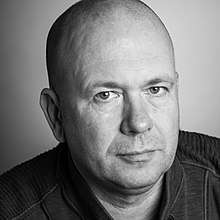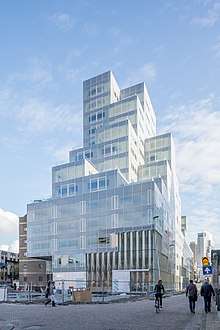Reinier de Graaf (architect)
Reinier de Graaf (born 1964) is a Dutch architect, architectural theorist, urbanist and writer. He is a Partner of the Office for Metropolitan Architecture (OMA), founded by Rem Koolhaas, and author of the book Four Walls and a Roof: The Complex Nature of a Simple Profession.
Reinier Hendrik de Graaf | |
|---|---|
 | |
| Born | 30 June 1964 |
| Nationality | Dutch |
| Alma mater | TU Delft; Berlage Institute |
| Occupation | architect writer |
Life
Reinier Hendrik de Graaf was born in Schiedam, Netherlands, where he graduated from Stedelijk Gymnasium in 1982.[1] He holds an architecture diploma from Delft University and a master's degree in architecture from the Berlage Institute. De Graaf worked for architecture firms in the Netherlands and the United Kingdom before joining OMA in 1996.
Work
OMA
Reinier de Graaf is Office for Metropolitan Architecture (OMA)’s longest serving non-founding partner. He is responsible for building and masterplanning projects in Europe, Russia and the Middle East, including De Rotterdam (2013); the new G-Star Headquarters in Amsterdam (2014), Timmerhuis (2015); Holland Green, the redevelopment of the former Commonwealth Institute (2016); Norra Tornen, two residential towers in Stockholm (due for completion in 2018); the RAI Hotel in Amsterdam (due for completion in 2019); and Mangalem 21, a new residential quarter in Tirana, Albania (due for completion in 2021). De Graaf has worked extensively in the Middle East and Russia, where he led the masterplan of the Skolkovo Innovation Centre (the “Russian Silicon Valley”) and the Greater Moscow Development Framework. His involvement in the future planning of Amsterdam Airport Schiphol and the Hamad International Airport in Qatar have caused him to be widely regarded as one of the world’s leading experts on the development of airports as urban systems.
AMO
Since 2002, De Graaf has directed the work of AMO, OMA’s think tank. AMO’s clients include Prada, Universal Studios, Condé Nast, Schiphol Airport, the Hermitage Museum, Harvard University and the European Union, for which in 2004 AMO conceived a new graphic identity, including a proposal for a new European flag. De Graaf is also responsible for AMO’s involvement in sustainability and energy planning, with projects such as Zeekracht: a strategic Masterplan for the North Sea; the 2010 publication Roadmap 2050: A Practical Guide to a Prosperous, Low-Carbon Europe for the European Climate Foundation; and The Energy Report, a global plan for 100 percent renewable energy by 2050, made with the WWF.


Teaching
In 2018, De Graaf taught a design studio at the Harvard University Graduate School of Design entitled, “Phantom Urbanism.”
From 2010-2013, De Graaf was involved in the founding and curriculum of the Strelka Institute for Media, Architecture and Design in Moscow, teaching diverse topics such as energy planning, the history of utopian predictions and the advent of the megacity. From 2014, he continued this research with graduate students at PennDesign, the architecture program at the University of Pennsylvania, under the title Megalopoli(tic)s, addressing the geopolitical implications of the megacity.
In 2011, De Graaf curated the exhibition On Hold at the British School in Rome about the impact of the financial crisis on OMA’s masterplanning work across the globe. The exhibition Public Works: Architecture by Civil Servants featured at the Venice Biennale in 2012 and at the König Galerie Berlin in 2013. De Graaf has published extensively (see below) and lectures frequently in the academic and professional realms.
In 2018, De Graaf was elected as the Sir Arthur Marshall Visiting Professor of Urban Design for 2018-19, in the Department of Architecture at the University of Cambridge[2][3].
Books
De Graaf co-authored three books on behalf of OMA: Content (2003), Al-Manakh I (2007) and Al-Manakh II, Gulf Continued (2010).
De Graaf’s first book under personal title Four Walls and a Roof: The Complex Nature of a Simple Profession appeared in 2017: a collection of essays – part historical, part inspired by personal experience – on the changing nature of the architecture profession into the 21st Century.

Reception
Four Walls and a Roof launched in September 2017 in London[4] and in Amsterdam[5] to great acclaim, with reviews published in Architectural Record, the Spectator,[6] Architects’ Journal,[7] and the Economist, which described Four Walls and a Roof as an "original and even occasionally hilarious book about losing ideals and finding them again."[8]
Paul Finch wrote of the book and its author:
“This is the most stimulating book on architecture and its practice that I have read for years, a perceptive analysis of how architecture represents, or connects with, wider political and economic movements and trends. The ambivalence with which architects approach their task, and the claims they make for themselves, are subjected to withering examination. The overall tone, which is one of brutal, not to say Brutalist, honesty, but even if de Graaf generally appears cynical about architecture and architects, one might bear in mind the definition of the cynic as ‘frustrated romantic’. You suspect he writes not from contempt, but love.”[9]
Further reading
- “A Benevolent Dictator with Taste”, Icon Magazine, October 2017.
- “The Inevitable Box”, Architectural Review, (Emap Publishing), no 1445 (October 2017).
- “How Architecture should adapt to Climate Change.” Time Magazine, September 22, 2017.
- “Architektur ohne Eigenschaften,” Baukultur in Deutschland: Von der Architekturqualität im Alltag zu den Ikonen der Baukunst, edited by Wüstenrot Foundation (Stuttgart: Kraemer Verlag, 2017).
- “With the Masses,” Architectural Review (Emap Publishing), no. 1433 (July / August 2016).
- “The Possibility of an Airport,” “Terminus: Transportation Special Issue,” Art Papers Magazine, January / February 2016.
- "Smart Technology Infiltrates Architecture,” Britannica Book of the Year 2016 (Encyclopaedia Britannica, 2016).
- “The Smart City Is the Ultimate Free- for- All,” Dezeen, December 4, 2015, https://www.dezeen.com/2015/12/04/reinier-de-graaf-opinion-smart-city/
- “Charisma Allows the Architect to Speak with Authority, Even When He Has No Clue,” Dezeen, September 29, 2015, https://www.dezeen.com/2015/09/29/renier-de-graaf-amo-oma-opinion-architects-charisma-eisenman-rossi-van-eyck/
- “Intruders: How Smart Technology Infiltrates Architecture,” Icon Magazine, November 23, 2015, https://www.iconeye.com/architecture/features/item/12333-intruders-how-smart-technology-infiltrates-architecture
- "Let Me Finish!", Online: “Academics Need to Break out of Their Loop and Get Back into the Real World,” Dezeen, November 4, 2015, https://www.dezeen.com/2015/11/04/opinion-reinier-de-graaf-american-architecture-academia-insular-get-back-to-real-world-chicago-architecture-biennial/
- “I Will Learn You Architecture,” “Learning,” special issue, Volume (Stichting Archis, the Netherlands), no. 45 (September 2015).
- “A Property Developer for President,” Huffington Post, September 8, 2015, https://www.huffingtonpost.com/reinier-de-graaf/a-property-developer-for-_b_8098036.html
- “Coup de Grâce: The Rise and Fall of Pruitt- Igoe, 1956–1972 and Beyond,” Blueprint (Progressive Media International) 340 (May / June 2015).
- “Building Capital,” Architectural Review (Emap Publishing), no. 1419 (May 2015).
- “Architecture Is Now a Tool of Capital, Complicit in a Purpose Antithetical to Its Social Mission,” Architectural Review, April 24, 2015, https://www.architectural-review.com/rethink/viewpoints/architecture-is-now-a-tool-of-capital-complicit-in-a-purpose-antithetical-to-its-social-mission/8681564.article
- “The Other Truth,” Metropolis, February 2015.
- “Where the Streets Have no Name,” Blueprint (Progressive Media International) 337 (November / December 2014).
- “Megalopolitics,” (With Laura Baird) Log (Anyone Corporation) 32 (Fall 2014).
- “If Mayors Ruled the World,” This Big City, September 30, 2014, http://thisbigcity.net/if-mayors-ruled-the-world/
- “Moscow after Moscow”, New Geographies 6: Grounding Metabolism, edited by Daniel Ibañez and Nikoz Katsikis (Cambridge, MA: Harvard University Press, 2014).
- "The Vast Majority of the Built Environment is of an Unspeakable Ugliness,” Dezeen, December 10, 2014, https://www.dezeen.com/2014/12/10/reinier-de-graaf-opinion-oma-the-built-environment-unspeakable-ugliness/
- “The Sum of All- isms: An Unsolicited Manifesto for the New Cities Foundation,” New Cities Foundation, June 2, 2014, https://newcities.org/sum-isms/
- “Balance of power: a renewed case for renewable energy for Europe.” De Volkskrant, May 4, 2014, https://www.volkskrant.nl/vk/nl/3184/opinie/article/detail/3651397/2014/05/08/Europa-heeft-meer-energie-dan-het-Midden-Oosten.dhtml/
- “From CIAM to Cyberspace: Architecture and the Community,” PROJ ECT: A Journal for Architecture (New York: Consolidated Urbanism), no. 3 (Spring 2014).
- "Public Works, Architecture by Civil Servants." CLOG: Brutalism Issue. Guest Editor Michael Abrahamson. March, 2013.
- “Bloody Fools! The Story of Pimlico School, 1970–2010,” Common Ground: A Critical Reader, from the 13th International Architecture Exhibition at La Biennale di Venezia, 2012 (Venice: Marsilio Editori Marittima, 2012).
- “At Your Service: Ten Steps to Becoming a Successful Urban Consultant,” “Al Manakh Cont’d,” special issue, Volume (Stichting Archis, the Netherlands), no. 23 (2010). Online: https://www.dezeen.com/2015/02/05/oma-reinier-de-graaf-opinion-10-tips-becoming-successful-urban-consultant/
- “Tackling Climate Change Still a Luxury in Developing World.” CNN International, August 17, 2011, http://edition.cnn.com/2011/OPINION/08/17/graaf.climate.change.bind/index.html
- “Look Past the Livability Ranks,” Financial Times, April 7, 2010, http://www.ft.com/intl/cms/s/0/e6d98b84-38d4-11df-9998-00144feabdc0.html#axzz32AyNRN9F/
- "A Hundred Copenhagens Could Not Bring the Changes We Need," Business Day, South Africa, 22 December 2009, De Verdieping Trouw, Netherlands, 22 December 2009 and New Times, Rwanda, 7 January 2010, http://oma.eu/news/a-hundred-copenhagens-could-not-bring-the-changes-we-need
- “The Future of Knowledge,” “Al Manakh,” special issue, Volume (Stichting Archis, the Netherlands), no. 12 (2007).
- "€-conography: How to Undo Europe’s Iconographic Deficit." (With Rem Koolhaas), Content (Taschen, 2003).
References
- "Final lecture in the lecture programme The Vincent Award 2006". 2010-12-03. Cite journal requires
|journal=(help) - "The Department is delighted to announce that the General Board has elected Reinier de Graaf as the Sir Arthur Marshall Visiting Professor of Urban Design for 2018-19, assigned to the Department of Architecture — Department of Architecture". Retrieved 2019-02-13.
- "Reinier de Graaf Appointed Visiting Professor at the University of Cambridge". OMA. Retrieved 2019-02-13.
- "Four Walls and a Roof, The Complex Nature of a Simple Profession". www.buildingcentre.co.uk. Retrieved 2017-10-31.
- "Reinier de Graaf (OMA) presentsBooklaunch: Four Walls and a Roof". Pakhuis de Zwijger. Retrieved 2017-10-31.
- "Lost in the metropolis | The Spectator Australia". The Spectator Australia. 2017-10-07. Retrieved 2017-10-31.
- "OMA's Reinier de Graaf writes not from contempt, but love". Architects Journal. Retrieved 2017-10-31.
- "When architectural idealism meets reality". The Economist. Retrieved 2017-10-31.
- "OMA's Reinier de Graaf writes not from contempt, but love". Architects Journal. Retrieved 2017-10-31.